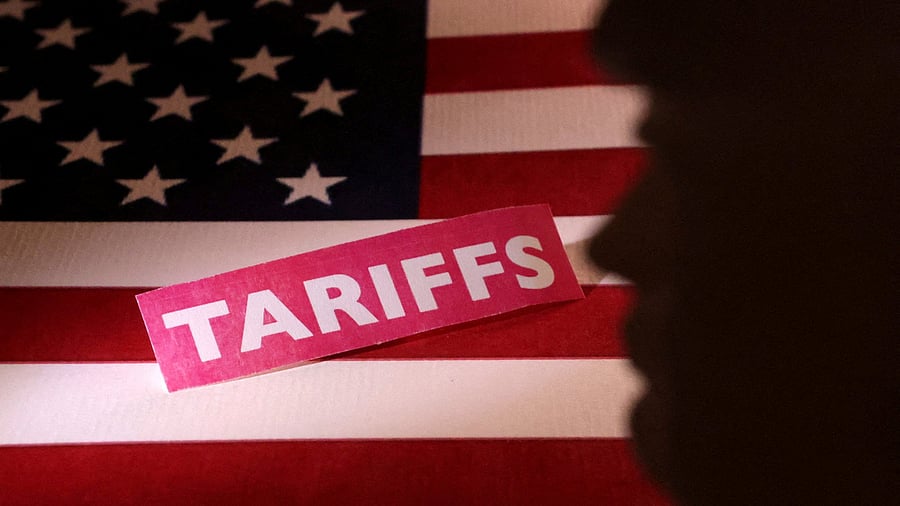
Credit: Reuters Photo
As attention is riveted to the impact of the US President Donald Trump’s reciprocal tariffs on the Indian economy, another insidious trend is gaining momentum: a rising demand for deeper protectionism. Calls are growing louder to continue the production-linked incentive (PLI) subsidy scheme to mitigate the looming trade crisis, which had first surfaced days earlier when the news of its discontinuation due to poor outcomes hit the headlines. Even the mobile phone industry—long showcased as PLI’s success story—is now asking for more support. Meanwhile, the government has announced a new PLI scheme worth Rs 22,919 crore for electronics and other component manufacturing from April 8, 2025.
There is also renewed demand for the restoration of recently discontinued export sops — such as the interest equalisation scheme (IES) and Remission of Duties and Taxes on Export Products (RODTEP) — and for a quick conclusion to bilateral free trade agreements under re-negotiation. As part of its second wave of protectionism, India reopened talks on several FTAs, concluding only four between 2021 and 2024 —with Mauritius, the UAE, Australia and the Trade and Economic Partnership Agreement (TEPA). The Centre is sympathetic to industry’s concerns, especially as the reciprocal US tariffs threaten to shave 30-50 basis points off India’s GDP growth.
Though the US has announced a 90-day pause on tariffs for all countries except China, its base line tariff hike of 10 per cent remains in force for others, including Indian (facing a 26 per cent rate) and the European Union (20 per cent). As a result, American buyers are now asking Indian exports to absorb part of this cost.
The first wave of protectionism, characterised by import substitution, failed between the 1960s and 1980s, culminating in the 1991 liberalisation. A revival began in 2014, initially unofficial and subtle. It took then Chief Economic Advisor Arvind Subramanian (2014-2018) to sound the alarm in October 2020, in a paper co-authored with Shoumitro Chatterjee titled India’s Inward (Re)turn: Is it Warranted? Will it Work?. By then, the prime minister had made it official, with the launch of the “Atmanirbhar Bharat” mission in May 2020.
Subsequently, a new ‘license-permit raj’ (non-tariff barrier) returned, marked by frequent and often overnight bans on trade in laptops/PCs/tablets, agricultural produce, metals, and more.
In 2024, the imposition of Quality Control Orders (QCOs) added another layer. Both Subramanian and Amitabh
Kant, former NITI Aayog CEO, have called for their immediate dismantling, citing harm to exports.
Indian industry has long enjoyed a plethora of subsidies. The corporate tax cut of September 2019 and the PLI subsidy (first disbursed in September 2022), are just the latest in this list. By then the 2015 ‘Make in India’ had failed to boost manufacturing outputs and exports. For decades, manufacturing industry has enjoyed subsidies, like tax holidays, refunds and incentives.
Like trade barriers, corporate tax cuts and PLIs were rolled out without evidence or logic. Finance Minister Nirmala Sitharaman, in her now-famous ‘Hanuman’ speech of 2022, admitted that these measures were adopted simply because the industry demanded them. Official data tell a sobering story:
(a) Manufacturing GVA fell to 17.2 per cent of GVA in FY25 (AE2) – from 18.1 per cent in FY16 (before ‘Make in India’) and 18.5 per cent in FY22 (before PLI).
(b) goods exports fell to 13.4 per cent of GDP in FY23 (up to which NAS’s disaggregate data is available) – from 17 per cent of GDP in FY14 (before import barriers came) and
(c) manufacturing jobs fell to 11.4 per cent in 2023-24 – from 12.1 per cent in 2017-18.
This decline comes despite the Indian Inc “swimming in excess profits” — a fourfold increase over four years, with profit-to-GDP at a 15-year high.
Not surprisingly, signs of disillusionment and desperation are now visible in the Centre’s responses. Sitharaman voiced concern over tepid private capex growth in both 2022 and 2025. CEA Anantha V Nageswaran echoed this in 2024, flagging stagnant wages, weak job creation, and low private investment.
More recently, Commerce and Industry Minister Piyush Goyal expressed frustration with start-ups, promoted through ‘Start Up India’, for focussing on food delivery apps, and boutique products, while their Chinese counterparts lead in AI, EVs, chips, and robotics. Just weeks ago, Goyal urged Indian industry to shed its protectionist mindset.
India’s flawed growth model has put the Reserve Bank in a bind. After taking steps to address liquidity concerns, the RBI found on April 3, 2025, that banks had parked surplus liquidity of Rs 4.13 lakh crore with it (SDF deposits). This is a symptom of bank credits driven by personal loans for consumption, not for production of goods and services. Personal loans overtook credit for services in FY20 and industry in FY21, which continued until January 2025.
There is no evidence that a fresh round of protectionism would work. India needs to dismantle it and let its industry face global competition.
(The writer is a journalist and author of An Unkept Promise: What Derailed the Indian Economy)